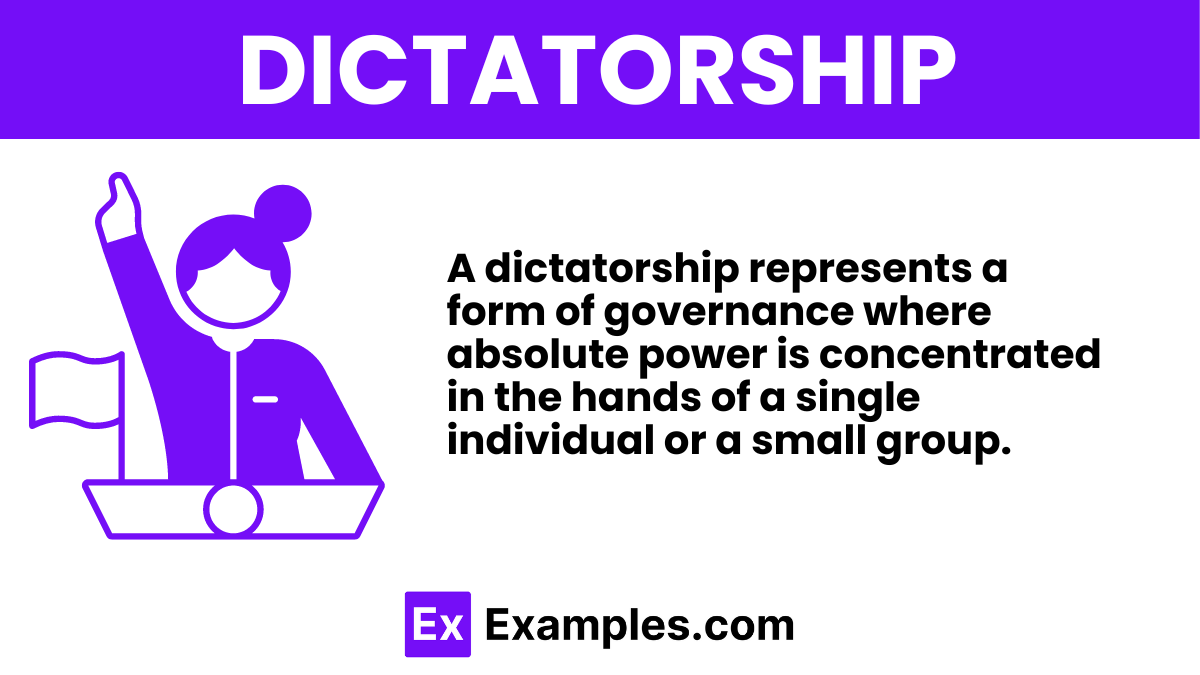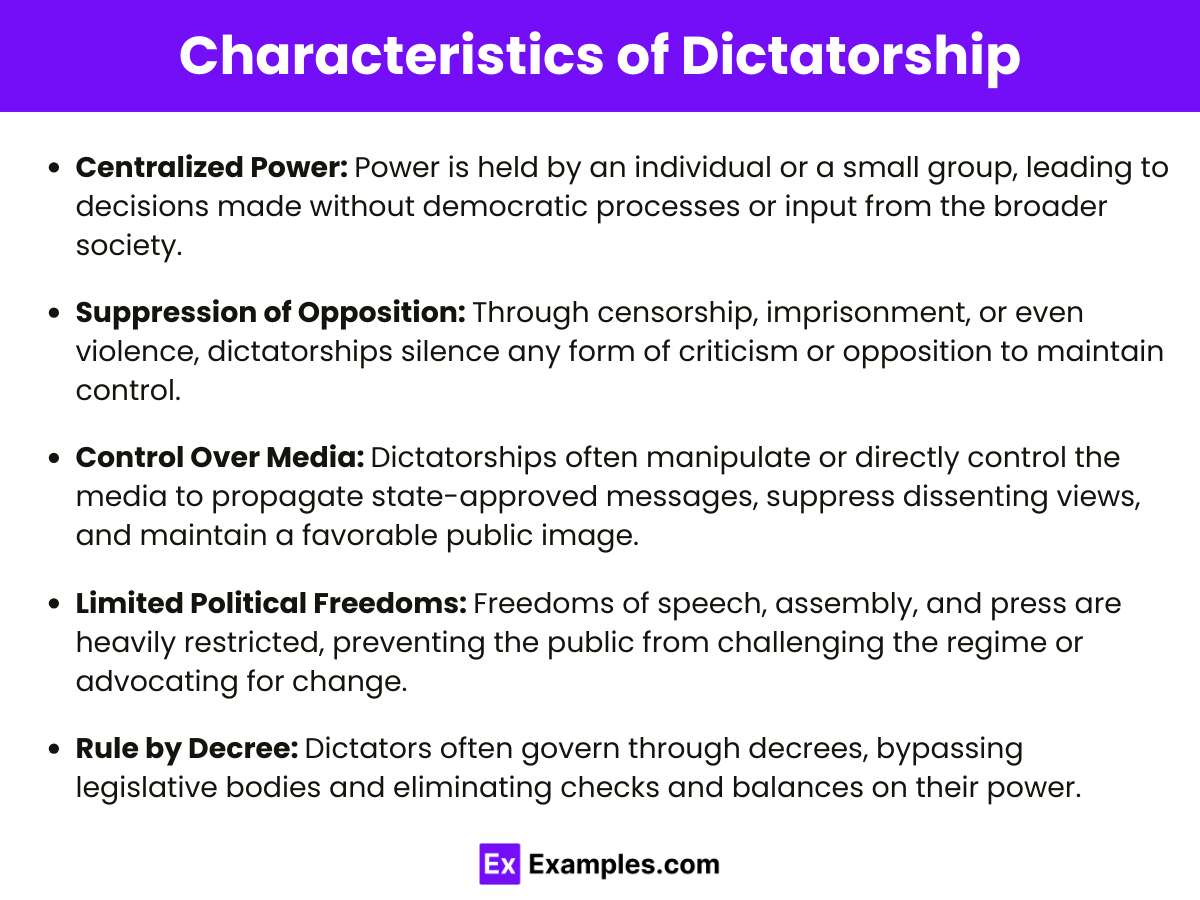Dictatorship Examples
A dictatorship represents a form of governance where absolute power is concentrated in the hands of a single individual or a small group. This comprehensive guide delves into the intricate mechanisms, historical evolution, and notable examples of dictatorships across the globe. By exploring the characteristics that define such regimes, including the suppression of political opposition, control over media, and the implementation of authoritarian policies, this guide aims to provide a deep understanding of the term “dictatorship.” Through examining various dictatorships, readers will gain insights into the dynamics that lead to the rise and fall of these powerful leaders and the impact their rule has on the societies they govern.
What is Dictatorship?
A dictatorship is a way of running a country where all the power is in the hands of one person or a small group of people. In a dictatorship, the leader, known as a dictator, makes all the big decisions without asking the people or their representatives. They don’t usually allow anyone to disagree with them or offer different ideas. This means that people living under a dictatorship often can’t say what they think or choose their leaders through fair elections. Dictatorships can be very different from each other, but what they all have in common is that one person or group has a lot of control over everything that happens in the country.
Types of Dictatorship
- Authoritarian Dictatorship: Focuses on strict obedience to a central authority, often at the expense of personal freedoms, but may allow some social and economic institutions to operate independently.
- Singapore under Lee Kuan Yew: Emphasized strict political control while promoting economic growth, with some social freedoms intact.
- Russia under Vladimir Putin: Centralized authority with limited political competition, maintaining a semblance of economic and social institutions.
- Totalitarian Dictatorship: Seeks to control every aspect of public and private life, through an ideology-based regime, often involving intense surveillance and repression of dissent.
- North Korea under the Kim dynasty: Controls all aspects of life, demanding absolute loyalty to the regime, with severe restrictions on freedoms.
- Nazi Germany under Adolf Hitler: Ideology-driven control over public and private life, utilizing propaganda and suppression to eliminate dissent.
- Military Dictatorship: Power is seized and maintained by military forces, often justifying their rule as a means to restore order or national unity.
- Egypt following the 2013 coup d’état: Military leadership justified their control as a temporary measure to restore stability.
- Argentina during the 1976-1983 military junta: Armed forces seized control, citing the restoration of order, leading to widespread human rights abuses.
- Constitutional Dictatorship: Operates under the guise of following legal frameworks, often using emergency powers to bypass traditional limits on government.
- The Roman Republic during emergencies: Assigned dictators like Cincinnatus absolute power for short periods to manage crises, adhering to a legal framework.
- France under the state of emergency laws: Certain periods saw expanded executive powers to address terrorism, ostensibly within legal boundaries.
Examples of Dictatorship
- Nazi Germany (1933-1945): Adolf Hitler’s regime is notorious for its totalitarian control, propelled by economic despair and national humiliation post-World War I. Remediation involved military defeat followed by international oversight and democratic rebuilding.
- Soviet Union (1922-1991): Under leaders like Stalin, the Soviet Union exhibited strict control over all aspects of life, driven by ideological zeal and power consolidation. Its collapse highlighted the importance of economic freedoms and political openness.
- North Korea (1948-present): The Kim dynasty’s hereditary rule exemplifies a dictatorship maintained through isolation, propaganda, and an oppressive security apparatus. International diplomacy and sanctions aim to curb its excesses.
- Fascist Italy (1922-1943): Mussolini’s rule was marked by authoritarianism, fueled by economic strife and nationalistic fervor. The fall of Fascist Italy underscores the effectiveness of allied military intervention and subsequent democratic transition.
- Pinochet’s Chile (1973-1990): Military coup led by Augusto Pinochet resulted in a brutal dictatorship characterized by human rights abuses. Transition to democracy was achieved through national plebiscites and international pressure.
- Zimbabwe under Mugabe (1980-2017): Robert Mugabe’s prolonged leadership turned into a dictatorship marked by economic mismanagement and corruption. Peaceful power transition strategies and election reforms were key to addressing the crisis.
- Francoist Spain (1939-1975): Francisco Franco’s nationalist dictatorship emerged from a civil war, relying on censorship and political repression. Its end came through Franco’s death, leading to a peaceful transition to democracy.
- Idi Amin’s Uganda (1971-1979): Characterized by human rights atrocities and economic collapse, Amin’s rule was ended by military intervention, which emphasizes the role of regional stability efforts and international aid in recovery.
- Saddam Hussein’s Iraq (1979-2003): Saddam’s regime was marked by severe repression and wars, rooted in power struggles and regional tensions. The resolution involved controversial military intervention, underscoring the complexities of external force in regime change.
- Gaddafi’s Libya (1969-2011): Muammar Gaddafi maintained a tight grip through wealth from oil and brutal suppression. His overthrow by a NATO-backed uprising illustrates the impact of international coalitions and the potential for civil unrest to spur change.
Characteristics of Dictatorship
Dictatorship, a governance model where absolute power is concentrated with a single leader or a select few, often arises during political turmoil or societal unrest. Characterized by authoritarian rule, these regimes suppress dissent, control the press, and prioritize state power over individual freedoms. Key characteristics include:
- Centralized Power: Power is held by an individual or a small group, leading to decisions made without democratic processes or input from the broader society.
- Suppression of Opposition: Through censorship, imprisonment, or even violence, dictatorships silence any form of criticism or opposition to maintain control.
- Control Over Media: Dictatorships often manipulate or directly control the media to propagate state-approved messages, suppress dissenting views, and maintain a favorable public image.
- Limited Political Freedoms: Freedoms of speech, assembly, and press are heavily restricted, preventing the public from challenging the regime or advocating for change.
- Rule by Decree: Dictators often govern through decrees, bypassing legislative bodies and eliminating checks and balances on their power.
Difference between Democracy and Dictatorship
| Democracy | Dictatorship |
|---|---|
| Power derives from the people through elections. | Power is concentrated in the hands of an individual or a small group. |
| Decisions are made through consensus or majority rule. | Decisions are made by the leader or ruling party without public input. |
| Citizens enjoy freedom of speech, assembly, and press. | These freedoms are restricted or suppressed. |
| Laws apply equally to all citizens, leaders included. | Laws may be arbitrarily applied or ignored by the ruler. |
| Leaders are accountable to the public and can be removed from office. | Leaders are not accountable to the public and remain in power through coercion or support from the military or elite. |
| Public participation in political processes is encouraged and protected. | Public participation is limited or non-existent, with political opposition often being suppressed. |
History
- Roman Dictatorship: Historically, the concept of dictatorship dates back to the Roman Republic, where it was established as a temporary emergency government mechanism. A dictator was appointed by the consuls and given supreme authority for a limited period, usually six months, to deal with national crises. Notable examples include Cincinnatus, who relinquished his power voluntarily after resolving the crisis he was appointed to manage. This early form of dictatorship was intended to be a safeguard for the republic, not a means of oppression.
- 20th Century Totalitarian Regimes: The 20th century saw the rise of totalitarian dictatorships, where leaders like Adolf Hitler in Germany, Joseph Stalin in the Soviet Union, and Benito Mussolini in Italy wielded absolute power. These regimes were characterized by aggressive nationalism, suppression of political opposition, control over the economy, and the pervasive use of propaganda and mass surveillance to maintain control over the populace. The impacts of these dictatorships were devastating, leading to World War II, the Holocaust, and the repression of millions.
- Military Dictatorships in Latin America: Throughout the 20th century, numerous Latin American countries experienced military dictatorships, often supported by external powers interested in maintaining political and economic influence in the region. Countries like Chile under Augusto Pinochet, Argentina during the “Dirty War,” and Brazil under its military government saw severe human rights abuses, including disappearances, torture, and suppression of political freedom. These regimes often justified their existence through anti-communism rhetoric, using it to consolidate power and control dissent.
- African Post-Colonial Dictatorships: Following the decolonization period after World War II, many African nations fell under the rule of dictators who came to power through coups or manipulated elections. Leaders like Idi Amin in Uganda, Mobutu Sese Seko in Zaire (now the Democratic Republic of Congo), and Muammar Gaddafi in Libya maintained their grip on power through patronage networks, state control of resources, and the suppression of opposition. These dictatorships often exacerbated ethnic tensions and contributed to prolonged conflicts and humanitarian crises.
- Communist Dictatorships: The 20th century also witnessed the establishment of communist dictatorships, most notably in the Soviet Union and China under leaders like Mao Zedong. These regimes aimed to create a classless society through the abolition of private property and the nationalization of industry. However, in practice, they often resulted in the concentration of power in the hands of a small elite, widespread human rights abuses, and significant economic hardships for the general population. The legacy of these dictatorships continues to influence global politics and the internal dynamics of the countries involved.
FAQS
Why is it called dictatorship?
It’s named for the Roman “dictator,” a role with complete authority, adapted to describe modern absolute rulers.
Who is an example of dictatorship?
Adolf Hitler’s regime in Nazi Germany is a quintessential example, marked by totalitarian control and oppressive governance.
Is democracy a dictatorship?
No, democracy is not a dictatorship. Democracy emphasizes rule by the majority, offering individual freedoms and institutional checks and balances.
In this comprehensive overview of dictatorship, we’ve explored its characteristics, historical examples, and impacts on societies. Understanding the nature of dictatorial regimes is crucial for recognizing the signs and advocating for democratic principles and human rights. By examining past and present dictatorships, we can better equip ourselves to prevent the rise of such governance in the future.





